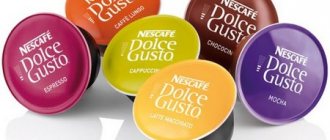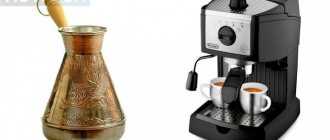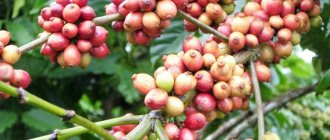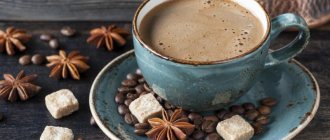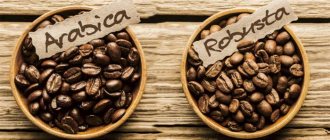Flavored coffee is not a new product in recent decades. Its history goes back many centuries. The first to perfect the drink were residents of the Middle East, who added various spices to it when cooking: cinnamon, cardamom, vanilla. Therefore, statements by connoisseurs of all things natural that modern marketers have spoiled the true taste of an invigorating drink with additives are absolutely groundless. Today, flavoring is not limited to a set of spices and herbs, and on store shelves you can find coffee with the most incredible additions.
Why is coffee flavored?
It is believed that the first to flavor coffee were the Arabs, who know how to brew it like no other. This was done to improve the taste, to help the coffee beans sparkle with new colors. Coffee with vanilla becomes softer, cinnamon and cardamom enhance its aroma and give new spicy shades; anise or even pepper was added for greater heat.
Now the aromatization process pursues the same goals as many years ago. And while coffee with a standard set of spices can be easily prepared in your own kitchen, achieving the aroma of amaretto, hazelnut or liqueur is not so easy. Therefore, industrial manufacturers add such aromas to coffee beans.
Flavored coffee gives you the opportunity to try a new taste, discover the unusual properties of your favorite drink, and combine several different flavors in one cup. Both conservatives and experimenters will find their own special product in a wide selection.
Some consumers believe that industrially flavored coffee can be harmful to health. Perhaps there is some truth in this, but if you buy a quality product, study the composition, timing, place of production and manufacturer, then there will be no consequences.
Flavorings for tea and coffee
Scorpio-Aromat LLC > Products > Tea and coffee flavors >
Scorpio-Aromat LLC, a Russian manufacturer of food flavorings, offers you flavorings in liquid form for the production of flavored tea and coffee.
The traditional technology for preparing flavored tea is to age the tea leaves together with aromatic herbs and fruits. Tea aromatization is carried out through the release of aroma-forming substances from plant materials and their further sorption on the surface of the tea leaf. When obtaining elite varieties of tea, the petals of the plant material are changed several times to achieve a bright, lasting aroma, then they are completely extracted. At the end of the process, the tea leaves are left with only the exquisite aroma of essential oils.
Use of Scorpio-AromatTM LLC flavoring agents in tea or coffee production:
- simplify the technological process of producing loose leaf tea with aromas of fruits, herbs and spices;
- the flavor is evenly distributed throughout the entire volume;
- highly soluble in aqueous media;
- significantly improves the organoleptic characteristics of the finished product;
- ensures the preservation of aroma throughout the entire shelf life of the product.
Having been producing flavors and researching the properties of flavored tea and coffee for more than 5 years, our company is ready to offer you a wide range of liquid flavors and aromatic compositions. Liquid flavors are manufactured taking into account the technological features of tea and coffee production. We have selected a dosage of flavoring that allows it to be optimally distributed, eliminating the tea leaf from getting wet and ensuring uniform distribution throughout the entire volume of the product.
By hovering your mouse and clicking on the name of the flavor,
You will learn more detailed information about it.
Tea flavors
| Name | Description | Note |
| Apricot 1122 | Bright apricot with a hint of dried apricots | |
| Pineapple 1001 | Aroma of ripe pineapple fruit | |
| Pineapple-mango 2103 | The smell of a mixture of pineapple and mango, a mixture of tropical fruits | |
| Orange 1113 | Pronounced aroma of orange fruit with a hint of zest | |
| Banana 1131 | Ripe banana aroma | |
| Barberry 1162/14 | The aroma of traditional caramel Barberry | |
| Bergamot 9140/25 | Pronounced aroma of Argentine bergamot fruits | |
| Bergamot-pear 9141 | Pronounced aroma of Argentine bergamot fruits with a note of ripe pear | |
| Vanilla 1146 | Bright creamy vanilla aroma | |
| Vanilla honey 2304 | Aroma of creamy vanilla with a bright note of linden honey | |
| Cherry 1152/11 | Aroma of fresh ripe cherries with a slight hint of pit | |
| Cherry 1152/S3-2 | The aroma of fresh ripe cherries | |
| Blackberry - black currant 3500 | Aroma of ripe blackberries with a note of black currant berries | |
| Jasmine 9142 | Bright aroma of jasmine flowers | |
| Strawberry 1605/K8 | The aroma of fresh ripe strawberries | |
| Ginger 9061 | Ginger root aroma with a slight citrus undertone | |
| Caramel 2403/1 | Aroma: caramel aroma, with a slight hint of caramelized sugar | |
| Strawberry 1604/1 | Aroma of fresh, slightly overripe strawberries | |
| Strawberry 1606 | Aroma of strawberries lightly boiled with sugar | |
| Cranberry 7501/2 | The aroma of fresh pureed berries | |
| Cinnamon 9130/3 | Ground cinnamon aroma | |
| Kumquat 2013 | Kumquat flavor | |
| Forest berries 2000 | Aroma of a mixture of blueberries and raspberries | |
| Lemon 1903/4 | Lemon juice aroma | |
| Lemon1903/4 | Lemon juice aroma | |
| Raspberry 2002/ 5 | Fresh raspberry aroma | |
| Honey 2301/12 | Linden honey aroma | |
| Milk 2430/3 | Milk flavor for oolong tea | |
| Condensed milk 3303 | Sweet milk aroma for oolong tea | |
| Mint 7001/3 (curly) | Sweet mint aroma | |
| Sea buckthorn 2007 | Aroma of ripe sea buckthorn berries | |
| Peach 2604/14 | Aroma of ripe peach pulp | |
| Peach-mango 2602 | Aroma of a mixture of ripe mango and peach fruits | |
| Peach-rose 2606 | Aroma of ripe peach and rose petals | |
| Spicy 7108/18 | Aroma of ginger, nutmeg, cardamom, allspice and other spices | |
| Spicy 7108/4 (Christmas mixture) | Aroma of cinnamon, ginger, cardamom, cloves and other traditional Christmas spices | |
| Rose 2010 | The scent of rose petals | |
| Homemade cream 3210/A1 | Milk cream aroma for oolong tea | |
| Currant 3001/6 | Aroma of black currant, pureed with sugar | |
| Herbs-spice 1915/2 (thyme) | Thyme aroma | |
| Thyme-Melissa 9063 | The aroma of a mixture of herbs of thyme and lemon balm | |
| Cherimoya-quince 9064/2 | Aroma of a mixture of tropical fruits and quince | |
| Blueberry 3904 | Aroma of blueberries pureed with sugar | |
| Blueberry 3904/7 | Fresh blueberry aroma | |
| Chocolate 1202/2 | Natural chocolate aroma | |
| Apple 3403/8 | Aroma of green apple with a pronounced note of apple juice |
Coffee flavors
| Name | Description | Note |
| Orange 1113 | Pronounced aroma of orange fruit with a hint of zest | |
| Vanillin 4000/14 | Bright vanilla tone | |
| Vanillin 4000/14KT | Bright tone of crystalline vanillin | |
| Vanillin 4000/18 | vanilla aroma with a light baking note | |
| Vanilla 1146 | Bright creamy vanilla aroma | |
| Vanilla 1147 | Bright aroma of natural vanilla | |
| Vanilla honey 2304 | Aroma of creamy vanilla with a bright note of linden honey | |
| Vanilla-cream 4001 | creamy aroma with a pronounced note of vanilla | |
| Cherry 4026 | cherry aroma with a note of stone | |
| Bitter almonds 1181 | aroma of bitter almonds, Amaretto liqueur | |
| Grillage 2406 | aroma of hazelnuts roasted in sugar, with a light vanilla note and a hint of almond seed | |
| Jasmine 4028 | scent of jasmine flowers | |
| Ginger 9061 | Ginger root aroma with a slight citrus undertone | |
| Iriso - creamy 2405 | Pronounced creamy note with a slight aftertaste of caramelized sweet milk | |
| Irish cream 4021 | butter liqueur aroma | |
| Irish cream 7112 | “the aroma of the famous Baileys cream liqueur” | |
| Cappuccino 7110 | Cappuccino coffee aroma | no cinnamon note! |
| Caramel 2403/1 | Aroma: caramel aroma, with a slight hint of caramelized sugar | |
| Milk caramel 6002 | milk caramel aroma | |
| Milk caramel 6002/2 | aroma of traditional candy "Korovka" | |
| Creamy caramel 4005 | creamy caramel aroma | |
| Cinnamon 4024 | cinnamon flavor | |
| Cinnamon 9130/3 | Ground cinnamon aroma | |
| Coffee 1401/27 | The aroma of freshly ground coffee | High in natural coffee extract |
| Coffee 1401/28 | Bright aroma of freshly ground coffee | High in natural coffee extract |
| Coffee (mocha) 1401/29 | Bright characteristic aroma of freshly ground coffee with a pronounced note of chocolate | High in natural cocoa extract and coffee extract |
| Creme brulee 7115 | characteristic aroma of the Creme Brulee dessert | |
| Kumquat 2013 | Kumquat flavor | |
| Hazelnut 1991 | hazelnut aroma | |
| Raspberry 4006 | aroma of ripe raspberries | |
| Mango 4027 | mango flavor | |
| Honey 2301/12 | Linden honey aroma | |
| Almonds (roasted) 1181/7 | aroma of almonds roasted in sugar | |
| Almond 4013 | roasted almond aroma | |
| Milk 2430/3 | Milk aroma | |
| Milk 4002/6 | Pronounced milk powder tone | |
| Condensed milk 3303 | Sweet milk aroma | |
| Condensed milk 4017 | sweet condensed milk aroma | |
| Baked milk 4003 | baked milk aroma | |
| Sea buckthorn 4025 | sea buckthorn aroma | |
| Pepper (chili) 9120/4 | bright aroma of hot chili pepper | |
| Peach 2604/14 | Aroma of ripe peach pulp | |
| Peach 4012 | ripe peach aroma | |
| Peach-mango 2602 | Aroma of a mixture of ripe mango and peach fruits | |
| Peach-rose 2606 | Aroma of ripe peach and rose petals | |
| Ice cream 2310 | “Bright aroma of traditional ice cream “Plombir”” | |
| Ice cream 4018 | Ice cream flavor Ice cream | |
| Spicy (Nutmeg) 7108/5 | nutmeg flavor | |
| Spicy 7108/18 | Aroma of ginger, nutmeg, cardamom, allspice and other spices | |
| Spicy 7108/4 (Christmas mixture) | Aroma of cinnamon, ginger, cardamom, cloves and other traditional Christmas spices | |
| Condensed milk 3301/32 | aroma of condensed milk with a sweet-creamy aftertaste | new |
| Cream (country) 4019 | creamy aroma with a pronounced milky aftertaste | |
| Cream 4019 | sweet cream aroma | |
| Cream Village 3200 | Sweet milky-creamy aroma with notes of pasteurization and a light nutty note, bright milky aftertaste | |
| Homemade cream 3210/A1 | Milk cream aroma | |
| Milk cream 3207/A1 | Sweet milky creamy aroma | |
| Currant 3001/6 | Aroma of black currant, pureed with sugar | |
| Tiramisu 7121 | “the aroma of the famous Tiramisu cake.” A combination of buttercream, ground coffee and a spicy alcoholic note.” | |
| Tropical fruit 4011 | tropical fruit blend aroma | |
| Cherimoya-quince 9064/2 | Aroma of a mixture of tropical fruits and quince | |
| Blueberry 4010 | ripe blueberry aroma | |
| Chocolate 1202 | Chocolate flavor | High in natural cocoa extract |
| Chocolate 1202/2 | Natural chocolate aroma |
Types of coffee flavors
All coffee with flavors is divided into four large groups, within which several directions are distinguished. Coffee groups depending on flavor:
- floral-fruity;
- nut milk;
- chocolate;
- alcoholic.
There are two directions in the alcoholic group, on the basis of which new ones can be formed: amaretto and Irish whiskey. Despite the fact that both fillers are from the alcoholic group, their tastes are significantly different. Amaretto is a soft, sweet drink with unobtrusive liqueur notes. Irish whiskey makes coffee bright, invigorating with a pronounced alcoholic aftertaste.
The nut and milk group includes:
- Hawaiian nut . A tart drink with a pronounced nutty taste and aroma; some consumers even noted a slight viscosity.
- Vanilla cream . Delicate creamy taste with vanilla aroma.
- Creamy almonds . Typically bitter coffee with a strong almond aroma.
The largest group, which includes many tastes and aromas, is floral-fruity. Let us highlight the main directions in this group:
- Cinnamon . The spice can be added to both black coffee and a drink with cream. At the same time, the taste and aroma of the finished drink varies greatly. Sweet coffee with cream, complemented with cinnamon, takes on an even more dessert taste. And black becomes more aromatic, with an oriental spicy taste and a cinnamon aftertaste that appears after a while.
- Red orange . A traditional oriental recipe that has not taken root in European countries. For unknown reasons, not many Europeans appreciate the combination of coffee and citrus fruits.
- Cardamom . The aroma changes slightly when cardamom is added. But the taste is greatly enhanced, becoming brighter and more pungent.
- Cream . It is also included in the flower-fruity group. This is a familiar dessert option. After a properly prepared drink with cream, a light strawberry aftertaste remains, which is why it ended up in the flower-fruity group.
The chocolate group includes tiramisu and Bavarian chocolate.
How are coffee beans flavored?
One of the most common coffee flavoring technologies is the addition of essential oils directly to the beans. After preparing in the usual way and roasting, the coffee undergoes an aromatization process, i.e. Certain compounds are added to it to improve and enhance the taste.
Aromatic compositions for coffee are created from natural essential oils. In some cases, natural ingredients are used - vanilla pods, cocoa, nuts, berries, spices. And those odors that cannot be obtained by extraction are recreated in the aroma laboratory. This produces coffee that tastes like caramel, chocolate, nuts, almonds, etc.
Regardless of how the coffee will be flavored, the additives are added to the actual finished product. That is, the grains are pre-cleaned, dried, fermented, and roasted so that they develop a natural taste with fruit, citrus or berry notes, depending on the variety and area of growth.
Most often, flavored coffee is 100% Arabica, although some blends also contain high-quality Robusta beans. Coffee connoisseurs and coffee lovers prefer Arabica for several reasons. While Robusta beans contain more caffeine, Arabica has twice the amount of natural sugars and has a more pronounced "coffee" flavor when cooked. You will experience the same balanced taste, but with additional nuances, in flavored coffee.
Most existing flavored coffees are medium roasted. It is popular because it provides balance, smoothness and minimal acidity.
After roasting and before aromatization, coffee beans already contain about 800 different compounds that determine the overall taste of the drink. Among them are aromatic oils, salts, organic acids, sugar and other carbohydrates. Aromatic components added to coffee complement it with their subtle notes. At the same time, no one sacrifices the natural coffee taste; it remains just as original and interesting.
How to make flavored coffee
The structure of coffee beans becomes porous after roasting, which is why they are stored in tightly closed, airtight containers away from strong-smelling products. Manufacturers took advantage of this property and began adding oil-based flavors to still hot, freshly roasted grains. The grains are quickly impregnated with such additives and then packaged for sale.
You should look for such a drink in a specialized store that can provide quality certificates for the product.
Synthetic flavorings are also used by manufacturers; their combination allows you to achieve almost any taste and aroma. This does not mean that coffee with such additives will be harmful to health. The concentrates are diluted with solvents (alcohol, water or oil), the grains are treated with them, and then dried.
Sometimes the flavoring process is done during packaging. The raw materials are placed in a jar or bag pre-treated with an aromatic substance.
Coffee flavored in any way does not harm human health. But when choosing a natural product, you should choose one whose grains are flavored with natural oils without the addition of synthetic flavors.
Flavoring: why and how new flavors are added to coffee.
There are at least three ways to make your coffee taste like rum. We won’t take the one where you simply add rum to a cup of coffee, but let’s talk about the less obvious ones.
Green coffee flavoring.
Green grain easily absorbs odors, which means this property can be used for flavoring. One of the most common methods is aging green grain in whiskey or wine barrels. After roasting, coffee processed in this way acquires a special flavor profile, similar to candy with dessert liqueur.
American roasting companies are considered pioneers in this area - Ceremony Coffee made experimental batches back in 2014. Coffee Review founder Kenneth Davids conducted many tests on aging green coffee in alcohol barrels. Different types of coffee were kept from 6 to 24 weeks in whiskey, rum and wine barrels. In addition, they tried to flavor the green beans by placing them in containers with roasted crushed cocoa (nibs) and dried coffee flowers.
After a control cupping, Davids cautiously concludes that aging green grain in wine barrels may not alter its flavor as aggressively as aging in whiskey barrels. The aroma of whiskey often overwhelmed the natural flavor profile of the grain, especially “calm” varieties without dominant notes. On the other hand, in a couple of samples there was a synergy - the aroma of strong alcohol successfully complemented the natural potential of the grain.
Today, coffee aromatization in barrels has gone beyond isolated experiments. This is already a fashionable direction in coffee post-processing. Roasters do joint projects with distilleries or bars, producing interesting limited edition batches of aged coffee. In Russia, such collaborations are done, for example, Happy Roasters Coffee together with Bruce Bar. Their latest project is coffee from Tanzania aged in a sherry cask.
Adding flavors during the fermentation process.
Fermentation is part of coffee processing. The process occurs in the pectin layer around the grain. Microorganisms break down sugar, forming new substances, and the grain absorbs them like a sponge. By controlling fermentation, you can add the desired flavor to your coffee or change it completely.
In the last few years, specialty producers have been experimenting a lot with new, unusual fermentation methods. For example, this is carbon dioxide maceration, fermentation with the addition of additional bacterial cultures, fermentation with fruit or sugar.
Fermentation with fruit.
Coffee cherries - whole or peeled - are placed in a sealed tank, where a certain percentage of fruit or fruit juice is added. Fermentation time and temperature inside the tank are strictly controlled. Citrus fruits, cascara, and sugar cane juice are used as fruit additives.
Funky coffee.
Bacteria and yeast that break down the pectin layer of the coffee berry enter it from the external environment - water, soil, air. Since different coffee regions and different farms have different microclimates and environments, the strains of microorganisms will also differ, and therefore the taste of the coffee. Accordingly, if suitable strains of yeast or bacteria are added during fermentation, a new flavor profile of the grain can be achieved.
Different strains of microorganisms - both natural and artificially added - under controlled conditions (temperature, fermentation time, pH level) give coffee interesting, unusual taste characteristics. For example, notes of tropical fruits or strong alcohol. One of the most famous examples is fermentation with lactobacilli .
Note that 7-8 years ago, the alcoholic taste in coffee was considered a disadvantage. Experimental fermentations have greatly expanded the acceptable flavor range. Nowadays, cider, rum or whiskey in the taste of coffee are considered a highlight. This type of coffee is often described as funky - bright, catchy, flamboyant.
Coffee with cinnamon.
Natural or artificial? Perhaps the most common question asked about coffee, which has cinnamon as one of its main flavor descriptors. Of course, we are not talking about coffee that is flavored with cinnamon after roasting, but about coffee that has cinnamon as a descriptor obtained during processing.
At the 2022 World Brewers Cup, Irishman Stephen Houston presented the judges with coffee from Costa Rica with a distinct cinnamon flavor. According to the participant, this unusual descriptor is the result of processing. The farmer did anaerobic fermentation : whole coffee berries were kept in containers without access to oxygen.
The taste wow effect of this coffee sparked a fashion for varieties with similar taste characteristics and discussions about the “purity” of taste and the honesty of the producer. Did the cinnamon flavor really appear only due to anaerobic fermentation, or were cinnamon sticks placed in the container along with the coffee berries?
Coffee producers can indeed ferment coffee with various additives, including cinnamon. This is done in order to improve the taste of inexpensive grain, in order to position it as a new, unique product and sell it at a higher price.
What is pure coffee?
Specialty coffee is highly valued for its natural flavor characteristics – given by terroir and processing. But what are considered natural taste characteristics? Do they include those resulting from fermentation with the addition of fruits, lactobacilli or the same cinnamon sticks?
In the 1950s, there was a debate about whether coffee should be considered a product to which chicory or acorns have been added. Today, the issue of coffee purity is again relevant, only it has reached a new level.
The SCA article Understanding Shifting Coffee Identity Standards states that it is still difficult to come to a consensus on what constitutes pure coffee.
In the diversity of opinions, two groups can be distinguished: innovators and purists. Innovators believe that 100% pure coffee does not exist, since during the processing process substances from the external environment will always enter the grain - the same strains of bacteria. Manufacturers have the right to introduce new processing methods, increasing the quality and value of their product. Purists say transparency and honesty are important to coffee. The consumer has the right to know what is added to the grain - especially with regard to potential allergens. The question also arises whether it is fair to enter “added” coffee into quality competitions.
However, there are two aspects to consider. First of all, green coffee will still be roasted. The chemical composition will change, some of the “additives” will disintegrate. Secondly, you can add “something” to coffee in different ways. Adding artificial flavor is not the same as adding yeast strains during the fermentation process. Therefore, each controversial case - pure coffee or coffee plus “something” - is best considered separately.
Source https://soyuzcoffeestore.com/blog/tpost/zt7vcno681-aromatizatsiya-zachem-i-kak-v-kofe-dobav
Can you use flavored coffee in a coffee machine?
According to statistics, coffee machines in which a flavored drink was brewed are more likely to fail. This is because most flavors are oil-based, which makes the beans and coffee powder stickier. Waste adhesive coffee mass can cause several types of breakdowns:
- the plastic in the grinding compartment is damaged;
- The knives and millstones of the coffee grinder wear out quickly;
- The plastic brewing mechanism fails faster due to the accumulation of impregnated flavors on it and increased friction.
It is possible to brew flavored coffee in a coffee machine, but this may cause faster wear and tear on the consumables. Modern machines made from high-quality wear-resistant materials can easily cope with such a load.
Another reason why it is not recommended to use a coffee machine is the smell of the product. No matter how pleasant it is, it is very difficult to remove it from the coffee machine. Any coffee you make later will be infused with flavor.
Have you tried flavored coffee?
Yes
No
How to brew correctly
Since it is undesirable to use a coffee machine, it is better to choose a Turk or French press to brew a flavored drink.
If you use a carob coffee maker, then purchasing an additional holder, which will be intended only for flavored powder, will help to avoid extraneous odors.
In addition to the additional holder in the carob coffee maker, you will need an additional coffee grinder for flavored coffee. You cannot grind grains in a shared machine, as the smell will remain there for a long time.
Many cold cocktails are prepared based on flavored coffee, so it’s worth trying it not only in hot form.

